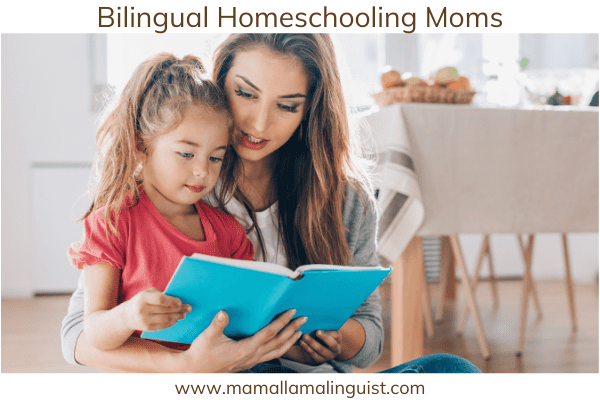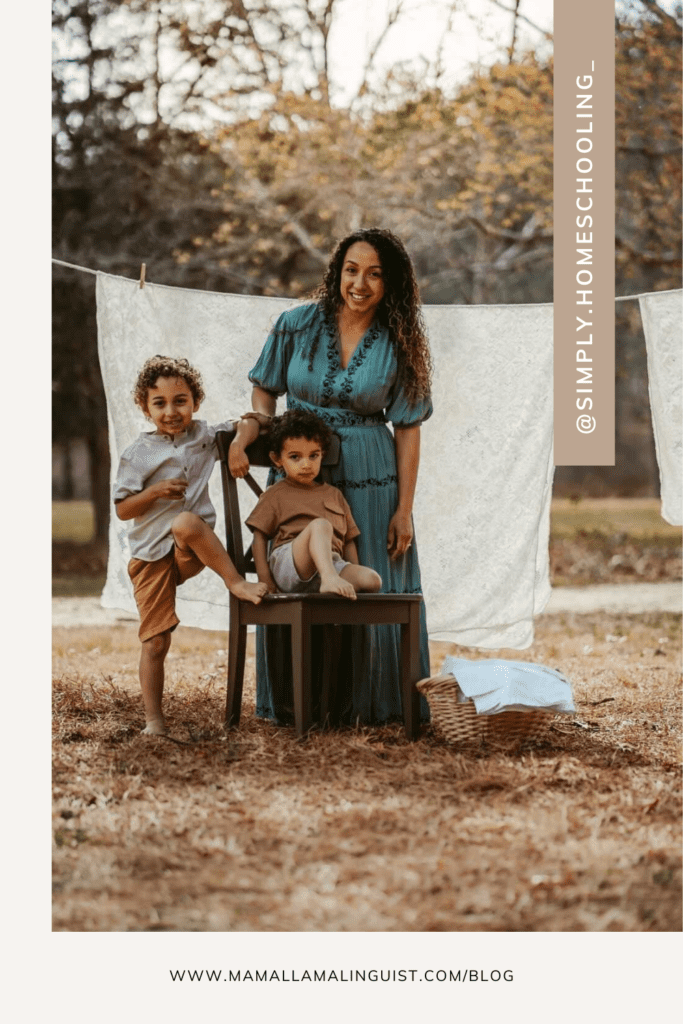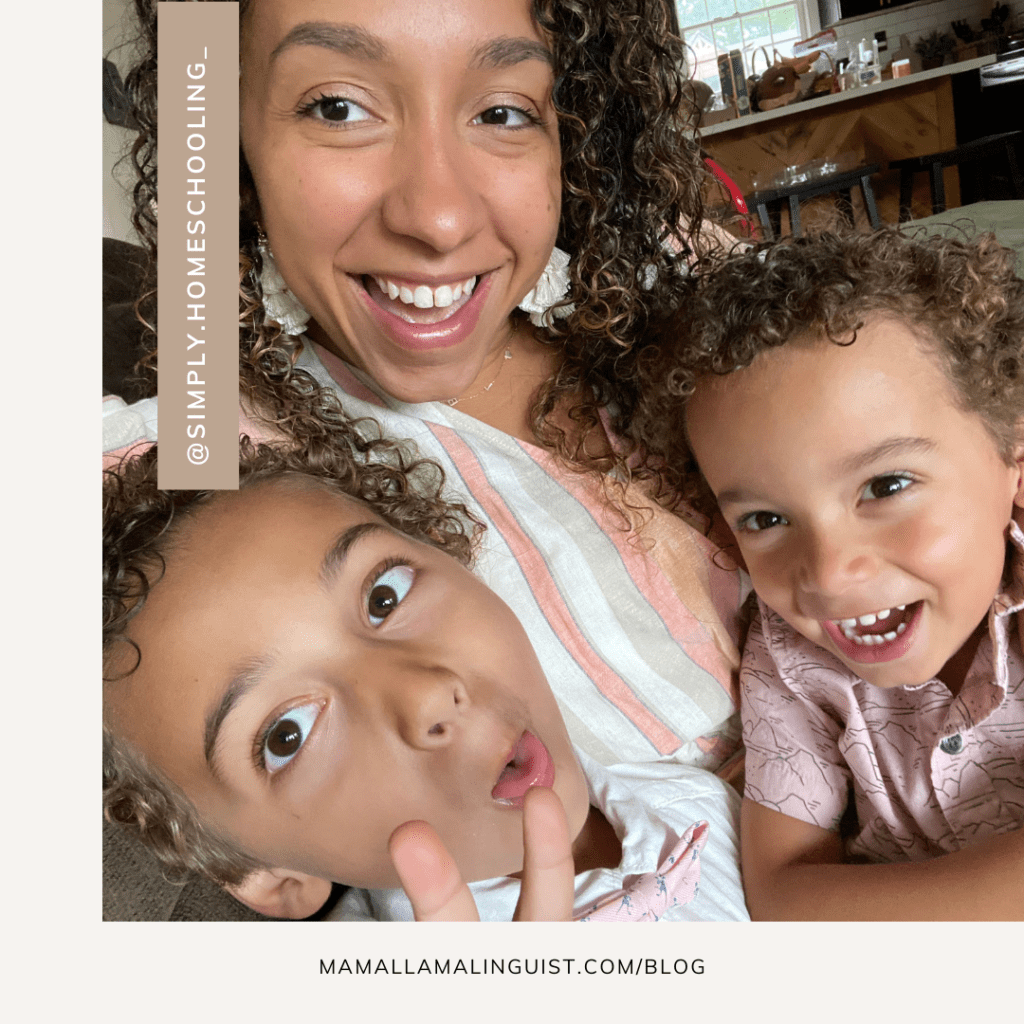In this post: Two moms share how they are homeschooling their kids bilingually in English and Spanish. From curricula and resources, to how they structure their days, enjoy this peek inside their bilingual homeschooling lives!
Are you thinking about homeschooling bilingually, but unsure how to approach it?
Maybe you are already homeschooling your kids in English and Spanish, but love hearing how other families structure their homeschool days, or what programs they use.
I am so happy to be sharing a little glimpse into the lives of two amazing bilingual homeschooling moms!

This post contains affiliate links. As an Amazon Associate I earn from qualifying purchases.
There are a lot of advantages to homeschooling including providing your child a more flexible and personalized education. Many bilingual families also turn to homeschooling to increase their child’s minority language input.
We are not a full time homeschooling family! My kids are attending a Dual Language Immersion Charter and I work during those hours. I realize living in California, these free DLI programs are more readily available than in other states.
We also supplement learning at home with curricula, lots of reading, music and games.
You can discover all our favorite Spanish educational resources in our Spanish Resource Hub.
So I decided to interview two full-time homeschooling mamas who are teaching their kids Spanish and English at home!
Jennifer is a native Spanish speaker whereas Adrienne is learning Spanish alongside her boys. I know you will love reading their stories!
Table of Contents
Meet our Bilingual Homeschool Moms
Jennifer Rosenberg @ourbilingualhomeschool
Hi! I’m Jenny, homeschool mom to my 10 year old son in 4th grade and my 7 year old daughter in 2nd grade.

My parents are from Colombia and Peru and I was born in Miami. We are a military family who moves around every couple of years. We are currently living in the Eastern Coastline of Connecticut and before that we’ve lived in Cleveland, Boston, West Virginia, and Pittsburgh.
My husband will be retiring from the Coast Guard after this tour and we hope to head back to Florida for good. My husband is American and has worked hard through the years to be proficient in Spanish to ensure that our children are bilingual.
Adrienne Grossmann @simply.homeschooling_
Hi! My name is Adrienne and I am a mom of two energetic, sweet & bright little boys, ages 6 and 4. I am from Long Island, New York and have lived here my whole life!

Why Homeschool Bilingually?
Jenny: Homeschooling was never part of my original plan, though my husband was homeschooled, I thought once my children were born, I would hire a nanny and go back to work.
However, once my son was born, my mindset changed instantly and we decided to pursue my husband’s military career so that I could stay at home with our son. Homeschooling then happened naturally.
From the start, I fell in love with the Reggio Emilia approach and I incorporated it in our home since my son was an infant. As he grew it all just evolved through the years and before I knew it we were doing Spanish Reggio inspired preschool at home.
Once my son turned 5, we were faced with deciding whether to enroll him in Kindergarten or continue homeschooling. I was so unsure of which way to go and it weighed heavily on me.
In my heart I knew homeschooling was the best choice for us and especially for our children. At that time, we began teaching our son English and started our dual language homeschool. We’ve never looked back.
Related Post: How to Raise a Bilingual Child

I’ve always been a passionate advocate for bilingualism, preserving our language and culture, while protecting childhood. I made it my mission for my children to be biliterate.
Dual language schools tend to work half the day in the partner language and the other half in English. Switching midday for us wasn’t working out so well and in order for me to guarantee a 50/50 exposure, I opted to alternate languages every day. We’ve been doing so for 5 years and it’s just been embedded into our daily lives. We do this every single day, even on the weekends, no matter where we are or who we are with.
My homeschool teaching mission is to ignite a passion for learning in my children and allow them the freedom to learn and grow at their own pace. I want to foster their curiosity, protect their childhood and encourage them to follow their dreams. To create an environment that provokes wonder, intellectual engagement, and countless opportunities to learn through play.
I want my children to not only be bilingual in English and Spanish, but to also stand up for their language, their roots, their culture. I want to inspire them to explore the complexities of our world and empower them to make it a better place.
Related Post: Authentic Spanish Nursery Rhymes

Adrienne: When I was in school I loved learning Spanish, so adding a foreign language early on for my boys was a no brainer. I wanted to give them the opportunity to hear, speak, and read Spanish.
As far as homeschooling, that was never something we truly considered until the pandemic. Although if I’m being honest, the thought of sending my son to traditional school didn’t sit right with me.
We started homeschooling in September of 2020, like many others, just to get him through what would’ve been his Pre-K year and keep him paced with his school going peers.
As time passed we quickly fell in love with homeschooling and the lifestyle it afforded us. The time we were able to spend together, the opportunity to pursue special interests, the ability to go at my son’s pace, and the chance to cultivate a true love for learning were things we cherished and weren’t willing to give up.

A Typical Bilingual Homeschool Day
Jenny: Our routines have evolved through the years as my children have grown. Our many moves have also caused our routines to shift often.
At the present time, I wake up at 6am and go to the gym while my kids are still asleep. At around 8:30 a.m. we start our day with morning time over breakfast. We move on to our schoolroom and begin working on our core subjects until noon. While one child works independently, I work one-on-one with the other and then we switch. My children are free to play in between lessons.

During lunch time, we do some of our family subjects. After lunch at about 1pm, we do our enrichment studies that vary each day. Over dinner, we usually play a family board or card game. I have a varied collection of educational games we love.
I am a Wild + Free group leader, so once a week we go on hikes or educational field trips with our group. My children also take various local homeschool classes throughout the year to further enrich their education.
Adrienne: In our homeschool we have found a rhythm works best for us more than a strict schedule. A rhythm allows us to be flexible and mindful of what we all need.
My boys are early risers so they start their morning with free play and educational screen time if they choose. We head to the table for lessons around mid morning.
They tend to head outside right before lunch to get their wiggles out & again afterwards.After they’re tuckered out from playing outside we usually head back inside to finish up our core work.
Favorite Homeschool Curricula
Related Post: Best Spanish Homeschool Curricula
Jenny: Must haves in our home are books, especially Spanish books. I have been collecting Spanish books since I was pregnant with my son and my collection continues to grow monthly it seems lol.
Every time family or friends travel, I order books for them to bring back for us. There’s a bookshop in Spain that I’ve been buying from for years called @literaturarespetuosa and I also order books through bookdepository.com.
I like to expose my children to different cultures, even within Latin America so I have books from authors of varying countries.
My favorite Spanish curriculum publishers are Santillana, Ediciones Coquito and Libros Águila.
My favorite curriculum by subjects are: Singapore Dimensions Math, All About Reading and Spelling, Abeka Grammar, Institute of Excellence in Writing, Memoria Press geography, Wordly Wise for vocabulary and Beautiful Feet Books Around the World with Picture Books.
Adrienne: We have been using the Learn and Live Letter for 2 years now and have had an amazing time with it! Their hands on, play based, and literature rich unit studies are so engaging and fun!
We supplement with All About Reading level 1 and some additional math resources. We also add in special interest and virtual classes, our favorite being Dino Club with Teacher Jackie.
Then for our Spanish lessons, we use the Llamitas Spanish curriculum! This Spanish curriculum ties in so well with our style of learning, the thematic units provide hands-on crafts and activities in a playful way and the audio tracks help so much with vocabulary & pronunciation, especially since we are not native speakers.
Challenges with Bilingual Homeschooling
Jenny: I think the biggest challenge has been the lack of resources for bilingual homeschool families. There aren’t any curriculum companies specifically geared for us so it’s all been a huge puzzle that I’ve had to piece together myself.
Every school year I spend countless hours scouring the internet, researching what resources other countries use, figuring out what would work best for our styles of learning, many times just resorting to creating my own materials. I typically use a variety of resources to teach in Spanish and I translate other subjects like math.
For example, on our Spanish days, when we are reading history (we use Abeka), I read in English but have our discussions in Spanish. I approach every subject a different way and I’ve figured out what works for us.
Adrienne: My biggest challenge in trying to incorporate another language in our homeschool is consistency. We always have fun and look forward to our language lessons but when we hit a busy season it seems like the first subject I put on the back burner.
Also being a non native speaker I at times feel overwhelmed and feel inadequate to teach my boys.

Tips and Advice for Bilingual Homeschoolers
Jenny: It’s not easy. It definitely takes a lot of hard work and dedication, but it’s worth it. So take the first step and go for it. Ask questions, do the research.
Read books on homeschooling in general, on the different philosophies, on the benefits of bilingualism, and how dual language programs work. Then, come up with a game plan for your family.
Think about your why and what you want to instill in your children. It will take many trials and errors, but you’ll find your way. Just trust the process.

Adrienne: My best advice for any family looking to homeschool bilingually is if it is what you and your family want to do, don’t let anything hold you back. If you are a non native speaker, you can learn alongside your children!
Choose resources and curricula that help foster a love for the language and culture in a way that fits your child’s learning style!
A huge thank you to Jennifer and Adrienne for sharing a glimpse into their bilingual homeschooling lives! For more Spanish homeschooling tools and resources, visit our Spanish Resource Hub!
Related Posts:
How to Raise a Biliterate Child
Best Bilingual Parenting Books
4 Popular Bilingual Parenting Strategies
Founder of the Llamitas Spanish® Curriculum and former Spanish teacher. Corrie holds two Master Degrees in Spanish and Education. She lives in San Diego, California with her husband and two bilingual children.
